Analysis of Substitution Saturation of nucleotide sequences
The substitutionhttp://www.postgradoquimica.cl/informacion-diplomado-en-bioinformatica-y-biologia-computacional/ saturation estimation is an essential analysis to check if the alignment sequences still maintain a phylogenetic signal. Saturation is much more common in nucleotide sequences. There are two methods: one extremely simple and qualitative and the other quantitative, with associated probability (the Xia method, 2009). Both are implemented in the program DAMBE (Xia, 2018).
DAMBE (Xia, 2018) is a suite with several phylogenetic and sequence analysis applications. Additionally, it is multi-platform (except if you run MacOS Catalina, as it is not completely 64 bits - Feb 2020) and simple to use. To our knowledge, it is the only phylogenetic analysis program that performs these tests.
The Qualitative Method
The qualitative method of substitution saturation analysis consists of analyzing a plot called "transition and transversals versus divergence" (transitions and transversals versus divergence). This method assumes that the distance calculated between the sequences is directly proportional to the divergence time between them, either on any scale.
The steps to obtain this graph are:
- Open the DAMBE program. Click on File and then on Open Standard Sequence File.

- Select the dataset VertCOI.fas. Click
Open. - In the dialog box that appears, called SequenceInfo, check the option Protein-coding Nuc-Seq. In this same window, in the Genetic Code options, choose the number 2 (from the Vertebrate mitochondria).

- In the main window, the alignment will appear in Clustal format.
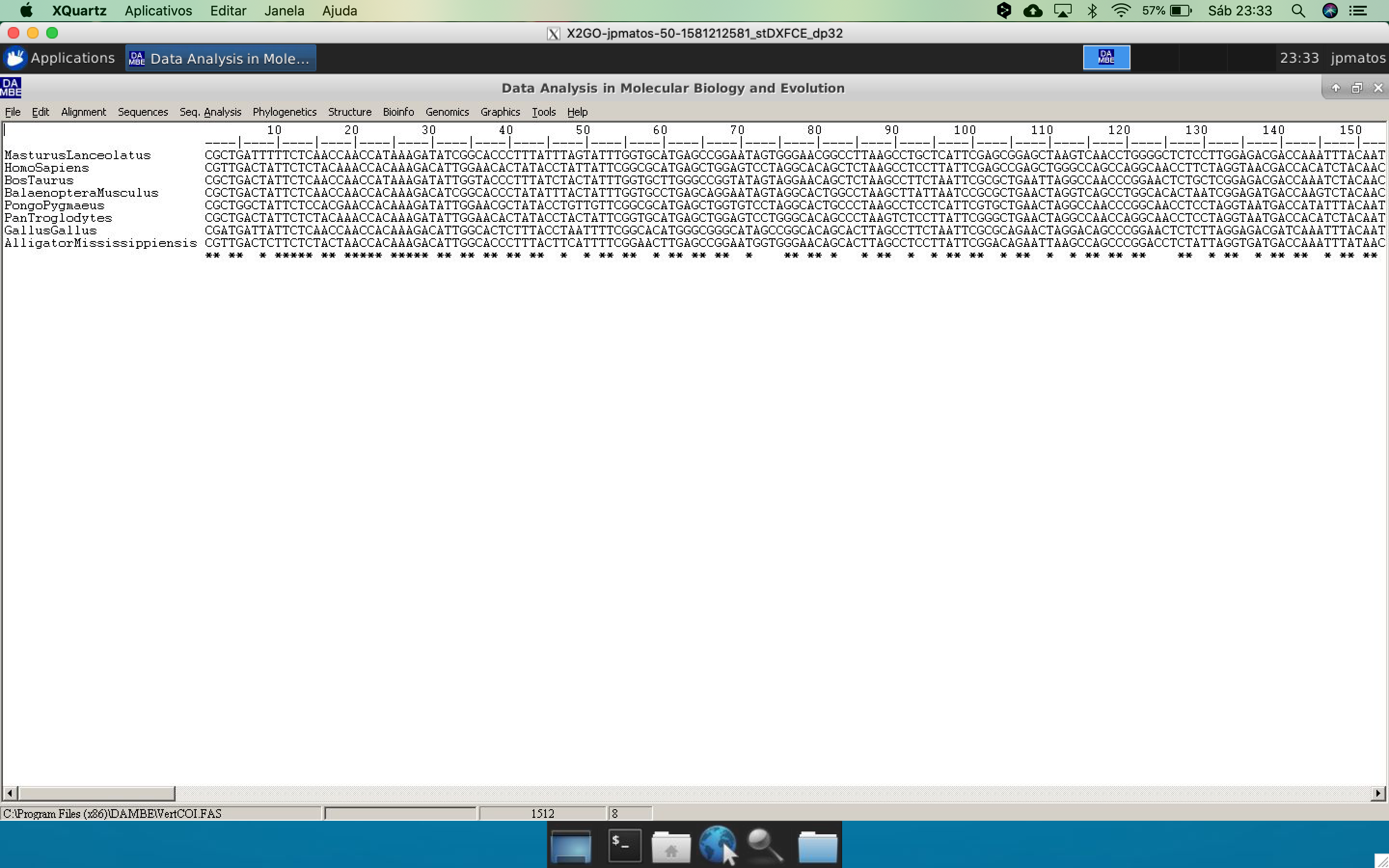
On DAMBE's main menu, go to Graphics and click on *transition and transversion versus divergence.
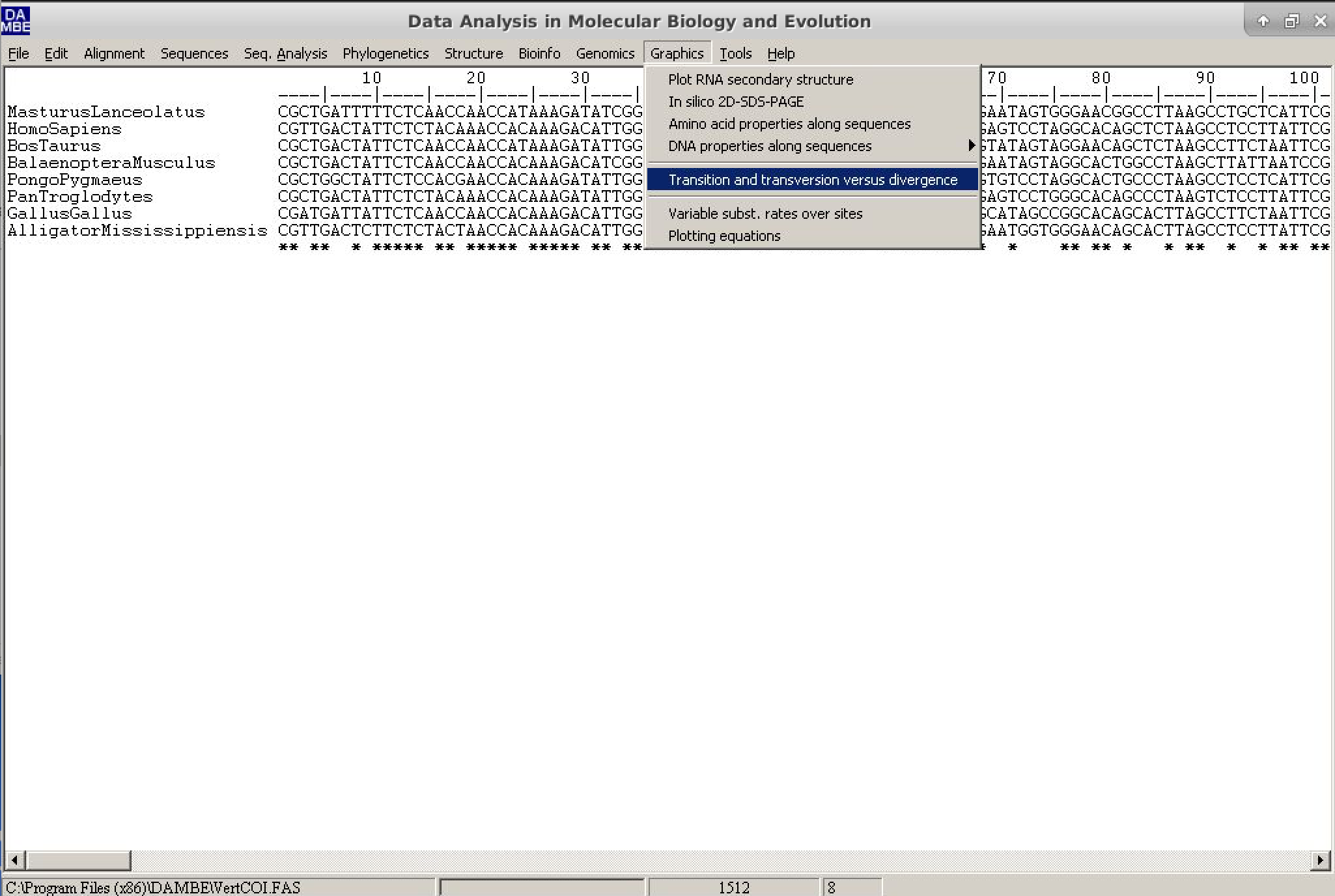
A new dialog box will appear. In it, the default values can be used. However, we will change the genetic distance (Genetic distance field) to TN93, as shown in the figure below:
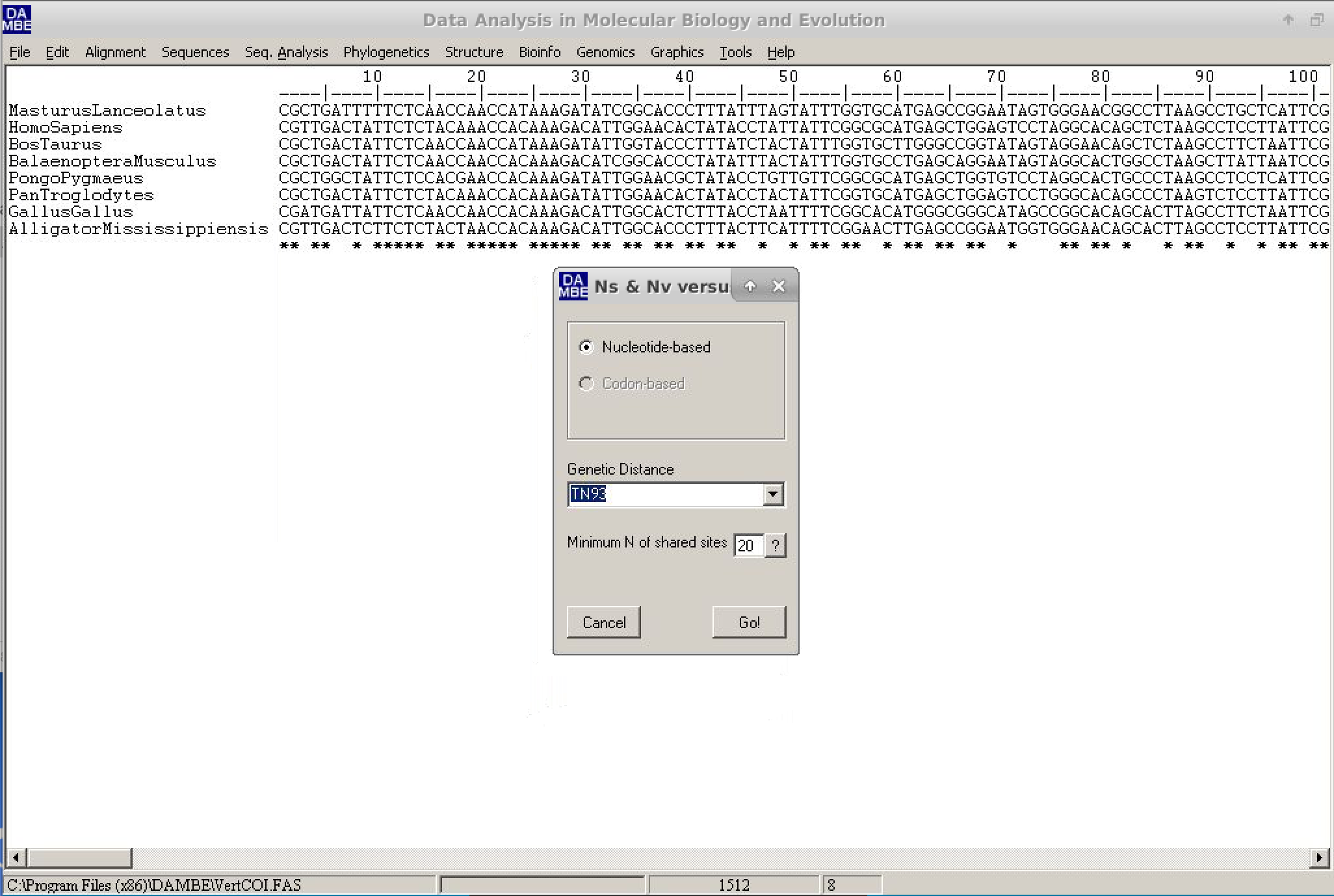
- Click on
Goand watch the resulting graph. To make the visualization easier, leave the options as below:
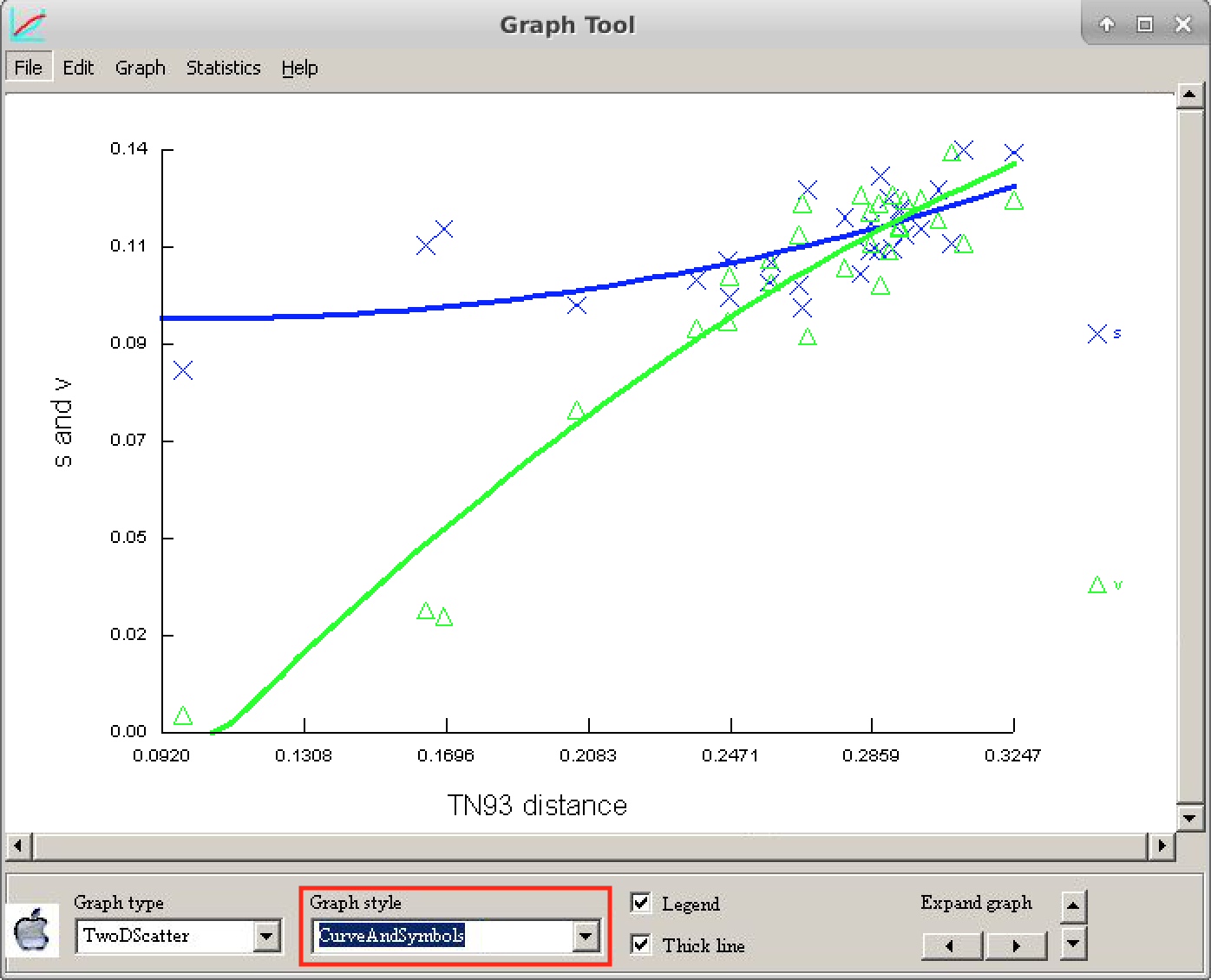
The letter "s" refers to the transitions and the letter "v" to the transversions*.
Compare the graph above with the figure below and draw your conclusions about the saturation of these sequences.

The quantitative method
The Xia method is a quantitative method, based on entropy, that assigns a significant value to the saturation of substitutions. It returns two criteria: Iss and Iss.c. The first is the substitution saturation index. The second is the critical substitution saturation index, which is the value of Iss at which sequences can no longer return the correct tree. When an observed Iss value is significantly lower than Iss.c (Iss < Iss.c), substitution saturation is not a problem for the dataset in question. The steps to perform this method are:
- Open the DAMBE program. Click on File and then on Open Standard Sequence File.
- Select VertCOI.fas dataset. Click on
Open. - In the dialog box that appears, called SequenceInfo, check the option Protein-coding Nuc-Seq. In this same window, in the Genetic Code options, choose the number 2 (from the Vertebrate mitochondria).
- In the main window, the alignment will appear in Clustal format. Before continuing, the proportion of invariable sites (Pinvar) should be calculated for this dataset. This parameter is crucial for sequences with very different substitution rates along with the sites.
- To do this, follow the path: Seq.Analysis > Substitution rates over site > Estimate proportion of invariant sites.
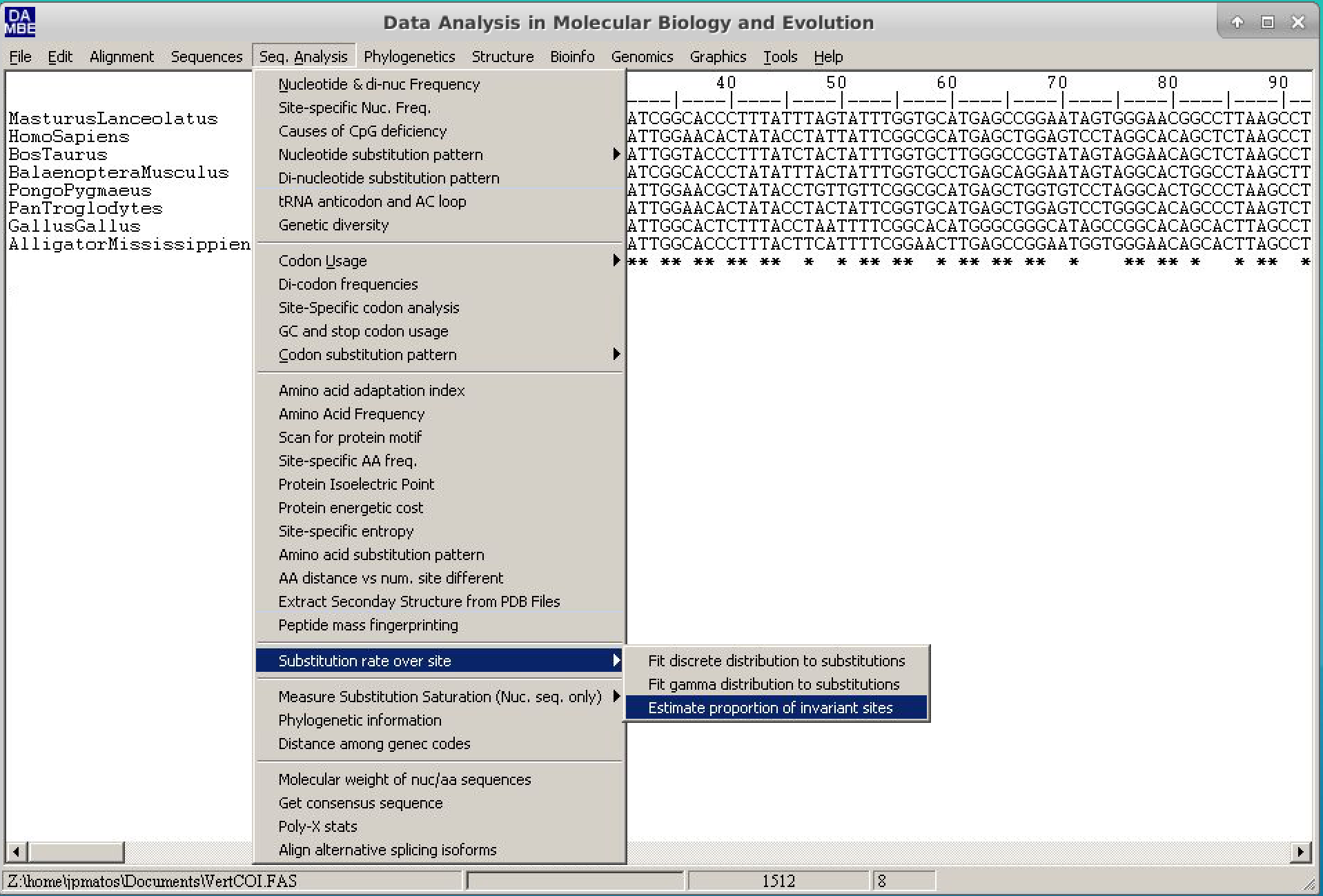
- In the dialog box that follows, check the "Use a new tree" option. In the new window, choose the Neighbor-Joining method, choose the appropriate outgroup (for this example, we will use Alligator mississippis) and keep the rest of the options the way it is. Click on
Runand then click onGo. At the end of the text output, Pinvar will be described, as below:
Estimation based on tree:
(AlligatorMississippiensis:0.13730,(MasturusLanceolatus:0.15730,(((HomoSapiens:0.04522,PanTroglodytes:0.04795):0.02113,PongoPygmaeus:0.08982):0.05970,(BosTaurus:0.09378,BalaenopteraMusculus:0.10744):0.01982):0.01484):0.01673,GallusGallus:0.12297);
Estimating the proportion of invariant sites by iteration.
(Poisson+I)
Iter Phi Pinv
-------------------------------------
0 0.85377 0.28746
1 0.85377 0.25871
2 0.85377 0.31960
3 0.73189 0.42154
4 0.62860 0.47955
5 0.57154 0.51389
6 0.56361 0.52394
7 0.56361 0.53330
8 0.56361 0.52737
9 0.56361 0.52462
10 0.56361 0.52224
11 0.56361 0.52258
12 0.56361 0.52122
13 0.56361 0.52089
14 0.56361 0.51988
15 0.56361 0.51954
16 0.56361 0.51887
17 0.56361 0.51821
18 0.56361 0.51754
19 0.56361 0.51688
20 0.56361 0.51621
21 0.56361 0.51555
-------------------------------------
P(invariant) = 0.51555
- Save or write down the Pinvar value (0.51555).
Depending on your operating system's language settings, you will have to use decimal notation as a period and not as a comma. Pay close attention to this.*
Now let us estimate the saturation of substitutions (the program may present some problems, and so, in some cases, the sequence file should be opened again).
- Click on "Seq.Analysis > Measure substitution saturation > Test by Xia et al.".
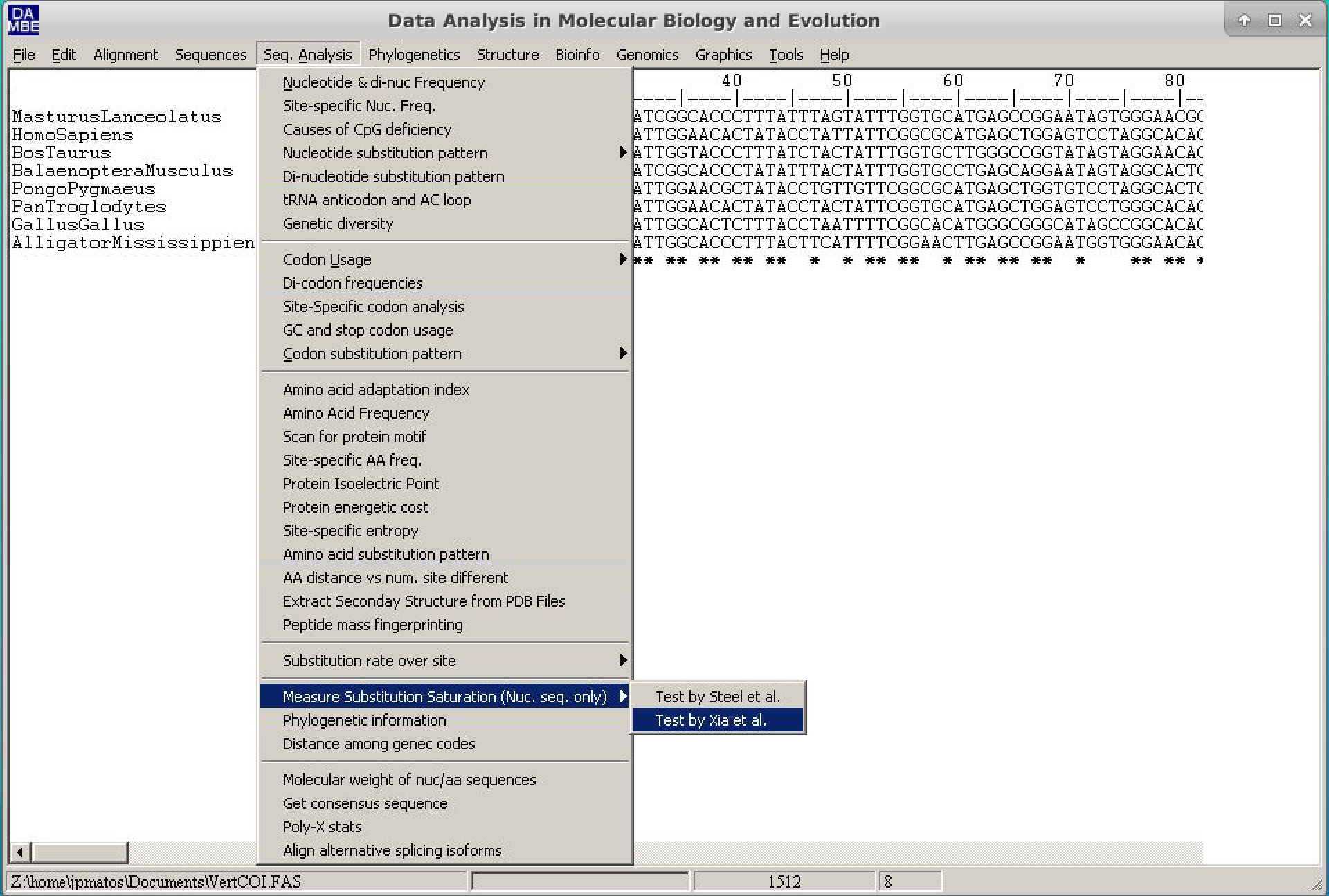
- In the window, just put the Pinvar value calculated and then click Go.
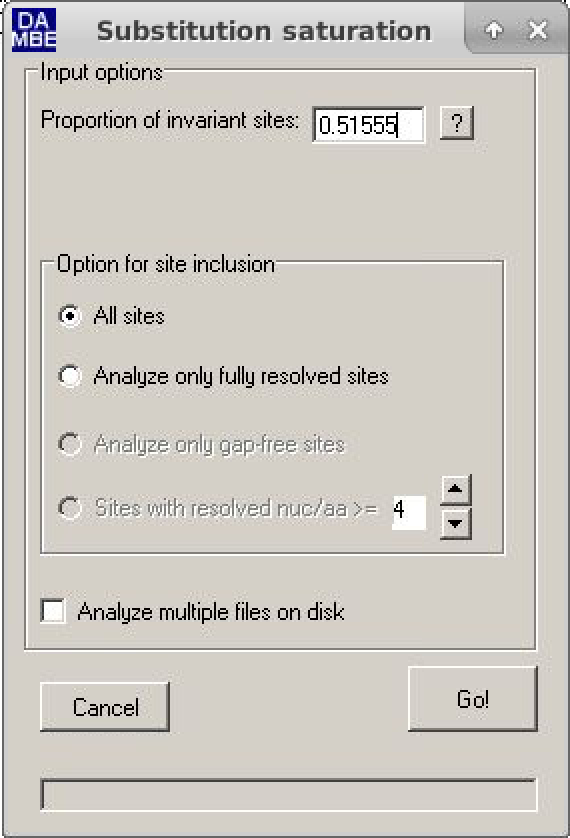
- Analyze the results (further comments will be made during the practice).
Test of substitution saturation (Xia et al. 2003; Xia and Lemey 2009)
Testing whether the observed Iss is significantly
lower than Iss.c.
Part I. For a symmetrical tree.
========================================================
Prop. invar. sites 0.5156
Mean H 0.9205
Standard Error 0.0183
Hmax 1.6517
Iss 0.5573
Iss.c 0.8093
T 13.7506
DF 731
Prob (Two-tailed) 0.0000
95% Lower Limit 0.5214
95% Upper Limit 0.5933
========================================================
Part II. For an extreme asymmetrical (and generally very
unlikely) tree.
========================================================
Iss.c 0.7095
T 8.3050
DF 731
Prob (Two-tailed) 0.0000
95% Lower Limit 0.5214
95% Upper Limit 0.5933
========================================================
Interpretation of results:
Significant Difference
----------------------
Yes No
-------------------------------------------------------
Iss < Iss.c Little Substantial
saturation saturation
-------------------------------------------------------
Iss > Iss.c Useless Very poor
sequences for phylogenetics
-------------------------------------------------------
Please cite:
Xia, X., Z. Xie, M. Salemi, L. Chen, Y. Wang. 2003. An index of substitution saturation and its application. Molecular Phylogenetics and Evolution 26:1-7.
Xia, X. and Lemey, P. 2009. Assessing substitution saturation with DAMBE. Pp. 615-630 in Philippe Lemey, Marco Salemi and Anne-Mieke Vandamme, eds. The Phylogenetic Handbook: A Practical Approach to DNA and Protein Phylogeny. 2nd edition Cambridge University Press.
It can be verified that both scenarios have Iss